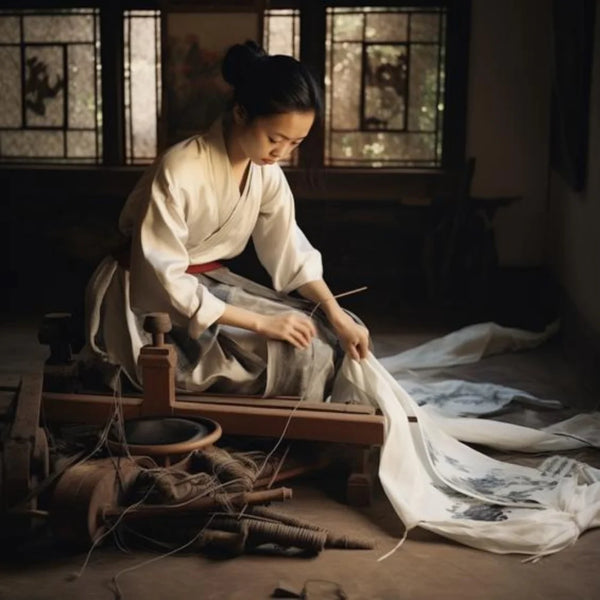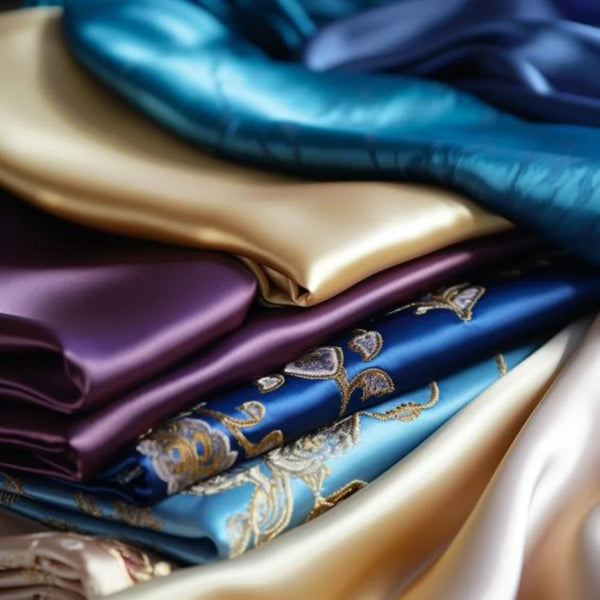Key Takeaways
satin and silk each have their advantages and disadvantages. Silk is a natural fiber that is more durable, resistant and thermoregulating. Satin is a fabric made from synthetic fibers like polyester, more affordable but less breathable.
For a silky feel, silk wins. But for bed linen like sheets, satin offers good value for money. Maintenance is easier for satin, silk requires precautions. In summary, silk is preferred for clothing and accessories, and satin for bedding.
The French brand The Oversized Hoodie® 🇫🇷 is famous for its textile expertise, notably its collection of high-end, 100% silk products certified Oeko -Tex® Standard 100. Free from toxic and chemical substances, and ecological, the collections natural silk pillowcase, night mask silk and silk sheets stand out for their incomparable softness and excellent value for money, providing an unrivaled feeling of comfort .
Understand the difference between satin and silk
Satin and silk have a similar appearance, soft and shiny. But these are two distinct matters:
-
Silk is a natural fiber produced by the silkworm. It is the only fiber of animal origin used for textiles.
-
Satin refers to a weaving technique creating a satin effect. The fibers used are often synthetic such as polyester, sometimes cotton.
While silk is a noble and precious material, satin is a more accessible alternative.
Also discover: Comparison of the 5 best silk pillowcases 2024
Origin and manufacturing: satin versus silk
Silk comes from the cocoon spun by the silkworm, a moth. This extremely fine continuous thread, measuring up to 3,000 m, is then woven to create fabric.
Silk weaving dates back to ancient China, almost 8,500 years ago, as recalled in the reference work “All about silk” from the Lyon Fabric Museum. . Today, China remains the world's leading producer.
Satin is a fabric with a satin appearance obtained using a particular weaving technique. Generally made of polyester, more rarely of cotton, it imitates the shiny effect of silk.
Unlike the latter, its manufacture is more industrial and less expensive.
At The Oversized Hoodie®, we are fascinated by the history and ancestral techniques behind the production of silk. It is a true treasure of know-how that has lasted for millennia.
— Geoffrey, Founder of The Oversized Hoodie®

Also read: How is silk made ?
Fabric characteristics: natural silk versus satin
Here are the main differences between these two fabrics:
-
Silk has a very soft and silky texture. The fabric slips between the fingers.
-
Satin shines but has a less pleasant feel, sometimes rough.
-
Silk is a natural and resistant fiber, satin contains synthetic fibers.
Our experience in the textile field has taught us that nothing beats the fineness of a real silk fabric. Even the most refined satin does not provide that characteristic ultra-silky touch.
— Geoffrey, Founder of The Oversized Hoodie®
Also read: Natural or synthetic silk ?
Advantages of each material
Silk has many advantages linked to its nature as a noble fiber:
-
It is very soft to the touch, almost fluid between the fingers.
-
It has great resistance to wear and excellent elasticity.
-
Silk is thermo-regulating, ideal in summer and winter.
-
It allows good breathing of the skin and absorption of humidity.
-
Silk is hypoallergenic and suitable for sensitive skin.
Also read: What are the Advantages and Disadvantages of Silk ?
Satin has other advantages:
-
It offers a shiny appearance imitating silk at a lower cost.
-
Its smooth, slippery texture provides a pleasant sensation.
-
Cotton satin may be suitable for allergy sufferers, provided it is 100% cotton. Discover here all the differences between silk and cotton satin.
-
It is a more affordable fabric than silk.
-
Maintenance of satin is easy. It supports frequent washing.
According to the study “Impact of textiles on the quality of sleep” from the Sleep Center of Foch Hospital, natural silk offers better thermoregulation, allowing better quality sleep compared satin.

Also read: Is silk warm ?
Disadvantages of these fabrics
Silk also has some flaws:
-
It is an expensive material, reserved for comfortable budgets.
-
Maintenance requires lots of precautions: hand wash, dry flat...
-
Silk is sensitive to humidity and UV rays. Poor maintenance damages it.
For satin:
-
The synthetic fibers in it do not breathe well.
-
Its smooth surface retains heat and perspiration.
-
Satin feel can become sticky with body heat.
-
Satin creases easily and holds wrinkles.
-
Its shine tends to fade after washing.
Satin retains more perspiration according to data from the study by the Sleep Center at Foch Hospital. Its less breathable texture can become sticky with body heat.
Also read: What are the types of silk ?
Satin or silk: which choice for optimal comfort ?
Silk wins for comfort, thanks to:
-
Its great silky softness.
-
Its natural breathing, ideal for the skin.
-
Its perfect thermoregulation, summer and winter.
Satin is suitable for occasional use, taking care to maintain it well. Its smooth surface tends to retain perspiration.
Prefer satin for bedding, and reserve silk for clothes worn next to the skin to benefit from its benefits.

Also read: What material to wear in summer ?
Silk or satin: which products to buy ?
Satin or silk sheets: which one to choose ?
For sheets, satin is a good compromise:
- Affordable price
- Easy maintenance, supports frequent washing
- Pleasant satin appearance
Silk remains delicate for daily use on a bed. Like the duvet cover, it will be damaged more quickly but will provide you with more benefits.
Also read: Choose your satin or silk sheets ?
Satin or silk pillowcase: impact on hair
Silk pillowcases are ideal for preserving the beauty and softness of hair.
Their benefits:
- Reduces friction and limits static electricity
- Leaves hair smooth, shiny, frizz-free
- Gently moisturizes
Satin is also suitable but natural silk is more breathable.
Satin and silk: which is the silkiest fabric?
Without a doubt, it is silk which wins the prize for the most silky fabric.
- Its softness is incomparable
- It slips between the fingers
- The satin touch does not provide the same delicate sensation
Satin or silk scrunchie for curly hair
To tie up curly hair, there's nothing like a satin scrunchie:
- Holds the hairstyle in place without damaging the curls
- Does not leave unsightly marks
- Avoid knots and the "frizzy" effect upon removal
Silk is more fragile and may break for this use.

Also read: Silk or Satin for Hair ?
Price comparison: silk and satin by the meter
- Synthetic satin: from €5 per meter
- Cotton satin: between €10 and €15 per meter
- Natural silk: minimum €50 per meter, up to €150 for very high quality
silk therefore costs up to 10 times more than satin per meter. It's an investment in durable pieces. Satin is suitable for more basic products or trials.
Also read: How to recognize silk ?
Textile care: how to take care of satin and silk?
satin is easier to maintain.It supports machine washing, even at 60°C, with a delicate program.
silk requires many more precautions to preserve the beauty of the fabric:
- Hand wash preferred
- Short cycle at low temperature
- Use detergent for delicate textiles
- Rinse thoroughly with clean water
- Avoid twisting, hang to drain
- Iron at low temperature, wrong side
- Dry flat, in the shade
Proper maintenance will extend the lifespan of your silk items.
Also read: Silk or satin for the skin ?
Conclusion
Satin and silk both offer a pleasant touch. But silk remains unrivaled for its extreme softness and natural qualities. It is the fiber the most noble.
This luxury product is worth the price for clothing and accessories against the skin. However, prefer the more resistant satin for bed linen subjected to regular washing.
FAQ
Is satin good for hair ?
Yes, satin is beneficial for the beauty of hair. Its smooth surface limits friction and static electricity. Hair is shinier and less tangled when you wake up.
What is the silkiest fabric ?
Without a doubt, it's silk! No other material matches the finesse and delicacy of this thread of natural origin. Even the softest satin does not provide the same ultra-silky feeling.
Which fabric is similar to silk ?
satin, thanks to its special weaving technique, is what best imitates the shiny and soft effect of silk. But no synthetic fabric can match all the qualities of this noble textile that is silk.
Is it good for hair to sleep on satin or silk ?
Yes, satin and silk are beneficial for preserving the beauty of hair at night. Their smooth fibers limit friction and the effects of humidity. When you wake up, hair is softer, shinier and frizz-free.
Cotton satin or silk ?
Real silk wins hands down for its incomparable softness. But cotton sateen is a good option for modest budgets or trials. Its texture remains pleasant.
Sources
[2] The sleep unit at Foch Hospital
Updated September 19, 2024







